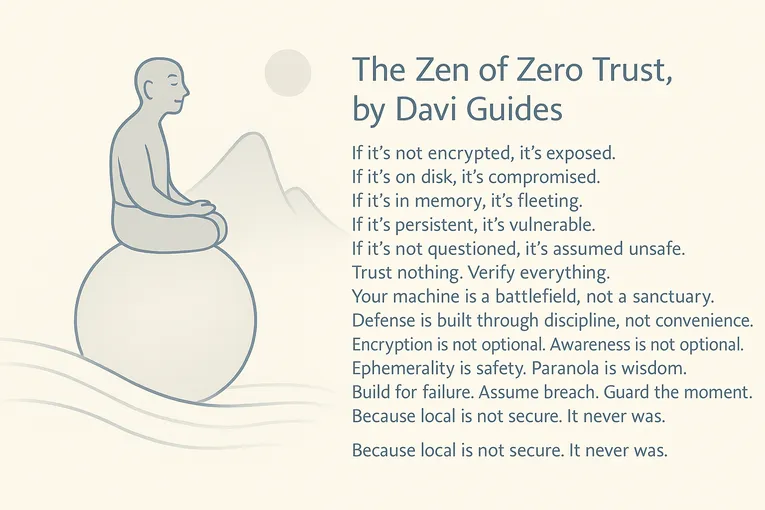
Zero Trust Local Env Manifesto
A philosophy for CLI development that assumes breach, encrypts everything, and trusts nothing local, ensuring secrets never persist in plaintext on disk.
> import zero_trust The Zen of Zero Trust, by Davi Guides If it's not encrypted, it's exposed. If it's on disk, it's compromised. If it's in memory, it's fleeting. If it's persistent, it's vulnerable. If it's not questioned, it's assumed unsafe. Trust nothing. Verify everything. Your machine is a battlefield, not a sanctuary. Defense is built through discipline, not convenience. Encryption is not optional. Awareness is not optional. Ephemerality is safety. Paranoia is wisdom. Build for failure. Assume breach. Guard the moment. Because local is not secure. It never was.
Premise
Traditional software development workflows treat local machines as “safe”. Tokens, API keys, credentials, and secrets are often stored:
- In plaintext
.envfiles - In shell
os.environvariables - In configuration files committed to repositories
- In home directories without encryption
This is a critical failure of assumption.
A local machine is no safer than a production server exposed to the internet. A breach can happen via malware, supply chain attacks, browser vulnerabilities, or physical access.
Local environments must be treated with the same skepticism and rigor as external systems.
Core Beliefs
- No trust by default: No file, process, or memory space is inherently secure.
- No plaintext persistence: Secrets must never be stored unencrypted on disk.
- Memory-only existence: Decryption should occur only transiently in RAM.
- Encryption everywhere: Local secrets must be encrypted with a secure, local-only key.
- Vault as a transport: Secrets stored in vaults should already be encrypted; the vault is not the sole protector.
- User responsibility: Developers must be made aware when handling decrypted secrets.
- Ephemeral workflows: Secrets exist only for the duration they are strictly needed.

How to Apply Zero Trust Locally
| Principle | Practice |
|---|---|
| Encrypt secrets before storing them anywhere | Use strong symmetric encryption (e.g., Fernet, AES) |
| Never save plaintext tokens or keys | Avoid .env, config.json, or unprotected files |
| Decrypt only in memory when absolutely necessary | No local caches, no temp files |
| Authenticate access to encrypted secrets | Use vaults + biometric/device authentication |
| Treat your local machine as a breachable surface | Don’t assume “only I have access” |
| Warn users about exposure points | Always make explicit when secrets are shown |
Why It Matters
- Developers are often the weakest security link.
- Local credentials often provide privileged access to production systems.
- Breaches originating from compromised laptops are increasingly common.
- Relying on “being careful” is not a security model. Designing for failure is.
KeySentinel: Built on Zero Trust
KeySentinel was created from these principles:
- Two-Layer Encryption (local + vault)
- No plaintext storage ever
- Memory-only decrypted access
- Immediate user warnings on sensitive operations
Using KeySentinel is an operationalization of Zero Trust Local.
Related Reading
Final Words
Assume breach. Encrypt everything. Trust nothing local.
Protect your secrets like they are the keys to your kingdom. Because they are.
Authored by Davi Luiz Guides
Part of the “Zero Trust Local Environment” series
Visit daviguides.github.io for more insights
